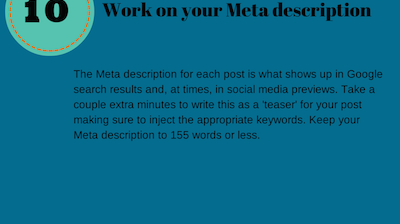If you’ve been publishing for a year or more, you probably have a hidden treasure trove of new content possibilities at your fingertips. Design tools are continually coming onto the market to help content marketers put a visual spin on their text. Often this software is inexpensive and easy to use – even for those of us with limited design ability. Here’s an example of how I took old blog posts and created several new pieces of content.
Resurrecting effective content
Review your publications to find evergreen content that can easily be repurposed into other formats. Look through you blog and your print articles to find titles that garnered a lot of sharing or comments. Blog posts are a great place to look, but any content including white papers, case studies, buying guides or video are all good candidates for repurposing.
I recently went through my blog and found two posts I thought would benefit from a refresh. They were both over four years old but had good information that was still valuable.
- 7 Tips for Starting a Blog, originally published 5 September 2010
- 9 Tips That Improved My Blog, originally published 19 April 2010
Repurposing your content into new formats
 I decided to merge the information in these two posts into a new piece of content called 12 Blogging Rules Every Content Marketer Should Follow. I could have written a new blog post but decided, instead, to create a PowerPoint presentation for SlideShare. To make it look attractive, I used Canva to design the slides.
I decided to merge the information in these two posts into a new piece of content called 12 Blogging Rules Every Content Marketer Should Follow. I could have written a new blog post but decided, instead, to create a PowerPoint presentation for SlideShare. To make it look attractive, I used Canva to design the slides.
Canva is a great tool, but I’ve seen too many brands get carried away with design. I didn’t want to spend a lot of time creating the new content but I wanted it to support my brand. I consulted the style guide supplied by my web designer and stuck closely to the recommended colour schemes for my website.
Shareable images
I then created a template for the slides and only changed the background colour for each new tip. Each slide contained one ‘rule’ and was largely text based. I mostly rewrote the tips – two to three sentences each – based on current technology and opinions formed with four additional years of experience.
PowerPoint presentation for SlideShare
Each slide was saved in .jpg format, instantly creating a perfect rich text image to share in social networking. I then copied each .jpg into PowerPoint. Within a couple of minutes, I had a deck I then uploaded to SlideShare. Before I even got around to writing this post, this piece of repurposed content garnered over 300 views and more than 10 downloads – all in about 5 days.
Creating an infographic
While I was happy with those results, I decided to use the same images and create an infographic. Using Piktochart, I loaded a cropped image of each .jpg into a blank template and created an infographic of the same content. I immediately uploaded my new infographic to Visual.ly. (Scroll to the end of this post to see an embedded version of this content.)
Without much more effort than it takes to write a new blog post, I’ve created a PowerPoint presentation, an infographic and 12 different .jpg images to share across social media. I’ve been able to distribute this new content to several places including:
- SlideShare
- Visual.ly
- Google+
- StumbleUpon
Over the next week or so, I’ll research other areas I can load this new content with the goal of attracting a new audience. In addition, it will give me the opportunity to distribute more content that links back to my website.
If you’ve invested time and effort to create content, chances are you can repurpose your best information. You will be creating new assets for your business, aiding your organic search rankings and potentially finding a new audience who didn’t see it the first time around.
What repurposing tips do you have for evergreen content?


Recent Comments